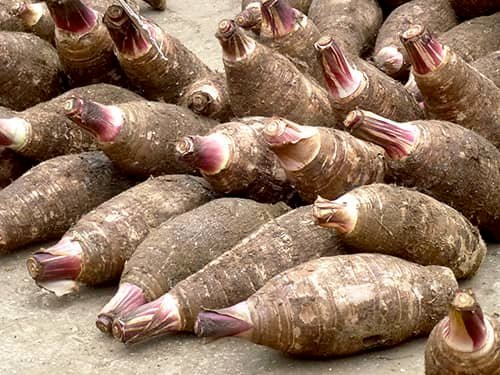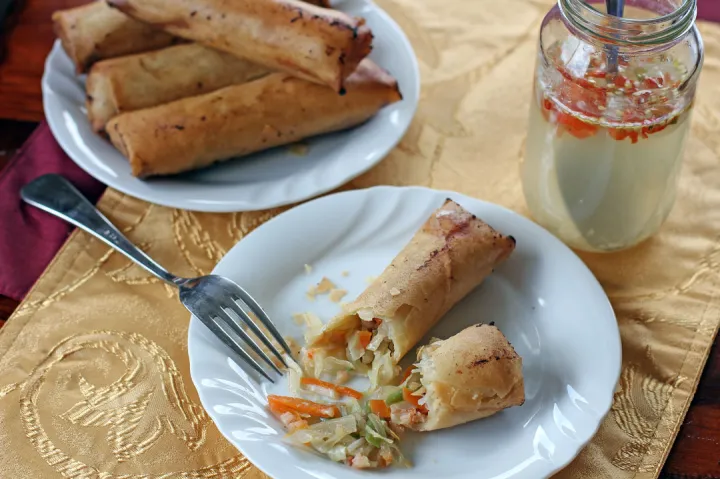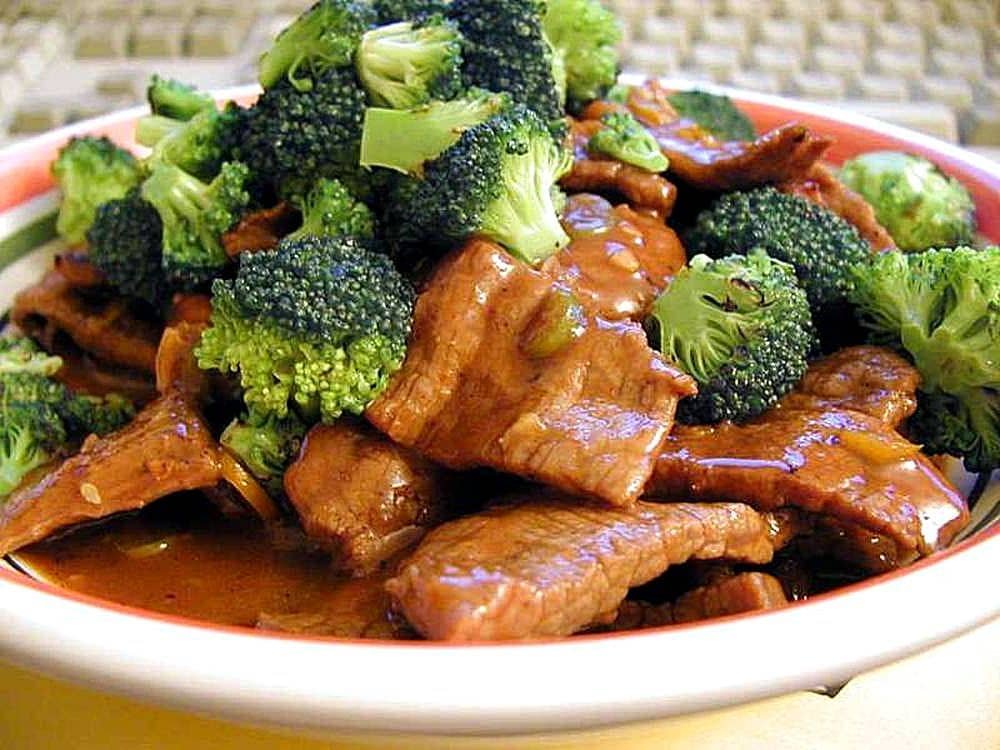Colocasia esculenta (L.) schott. or as widely known as Taro, but is sometimes called with its other common names cocoyam, dasheen, Colocasia, elephant’s ear plant, amadumbe, Arbi and kalo. In some countries like Philippines, people locally called it kamoteng kahoy and balinghoy or balanghoy.
Taro root is originally cultivated in Asia but is now enjoyed and used in many places all around the world. It is also one of the few crops that can grow in flooded areas, due to its petioles.
Other taro types include Xanthosoma sagittifolium (arrowleaf elephant’s ear), Cyrtosperma merkusii (swamp taro), and Alocasia macrorrhizos (giant taro).
Taro is a starch-rich, globular fleshy taproot of aroid family plants. Its underground root, known as a corm, is one of the traditional edible root vegetables.
The corm grows to a size of a turnip, has globular or oblong shape with brown, tough skin. Its surface is marked by circular rings indicating points of attachment of scaly leaves. Inside, its flesh is white to cream-yellow but may feature different colors depending upon cultivar types.
When cooked, it becomes soft and edible and has a mildly sweet taste and nutty flavor and a texture similar to potato or sweet potato.
Taro root has a very significant amount of dietary fiber and carbohydrates, as well as high levels of vitamin A, C, E, vitamin B6, and folate. It also contains magnesium, iron, zinc, phosphorous, potassium, manganese, and copper. Taro root also provides some protein.
Taro root contains a wealth of organic compounds, minerals, and vitamins that can benefit your overall health in a number of ways.
CHECK OUT THE BEST TARO ROOT HEALTH BENEFITS BELOW:
IMPROVES DIGESTIVE HEALTH
The high level of dietary fiber found in taro root makes it very important for supporting our gastrointestinal health and its important function role in digestion. This can help prevent certain conditions such as excess gas, bloating, cramping, constipation, and even diarrhea.
IMPROVES HEART HEALTH
Taro root contains a significant level of potassium, an essential mineral that we need to remain healthy and functional. Potassium not only facilitates healthy fluid transfers between membranes and tissues throughout the body but also helps to relieve stress and pressure on blood vessels and arteries.
IMPROVES COGNITIVE FUNCTION
The potassium present in taro roots has shown to increased cognitive function because neural connections can be boosted when blood pressure is reduced, and fluid transfer between neural membranes is optimized.
(See also: 11 Foods to Eat to Increase Your Brain Capacity)
IMPROVES VISION HEALTH
Taro root contains various antioxidants, including beta-carotene and cryptoxanthin. These antioxidants can help improve vision as well, by preventing free radicals from attacking ocular cells and causing macular degeneration or cataracts.
BOOST IMMUNE SYSTEM
Taro roots have a very high level of vitamin C in each serving and this vitamin helps to stimulate the immune system to create white blood cells, which defend the body from foreign pathogens and agents.
IMPROVES MUSCLE HEALTH
Taro roots contain vitamin and magnesium, both are vital for strengthening and improving the health of muscle, bone and nerves.
(See also: 6 Major Foods To Avoid If You Have Arthritis)
PREVENTS CANCER
The high levels of vitamin A, C, and various other phenolic antioxidants found in the taro root can boost our immune system and can help eliminate dangerous free radicals from our system. Cryptoxanthin found in taro root, is directly connected to a lowered chance of developing both lung and oral cancers.
(See also: Top 5 Anti-Cancer Vegetables)
PREVENTS DIABETES
Dietary fiber in taro root can also help lower the chances of developing diabetes because it regulates the release of insulin and glucose in the body. Also, it can better manage your glycemic levels and lower your chances of developing diabetes.
(See also: Top 9 Worst Food For A Diabetic)
INCREASED CIRCULATION
The dual presence of iron and copper in taro root make it a very important food to help prevent anemia and boost circulation throughout the body. Iron and copper are both essential for the production of red blood cells, which carry the all-important oxygen to your body’s organ systems.
SKIN CARE
Taro roots contain vitamin E and vitamin A, both of these essential vitamins work to eliminate skin conditions and boost overall cellular health, meaning that our wounds and blemishes heal faster, and a healthy glow can be returned to the skin.
(See also: 6 Great Food Items To Clear Your Skin)
REDUCE FATIGUE
Taro root is mainly consumed by athletes for long lasting energy. This is because it contains a low glycemic index which is good for athletes.
SLOWED AGING PROCESS
Taro roots are a very nutritious food that contains essential vitamins and minerals which are good antioxidants and is useful to protect against diseases and slow down aging process.
Taro root is an exceptionally healthy food, filled with numerous nutrients like vitamins, minerals, electrolytes, and antioxidants.
The taro roots and leaves both have great flavors and can be used in a variety of preparations. Taro roots are used to prepare curries, fried for chips, cakes, roasted, boiled, steamed, pureed etc.
WAYS TO ENJOY TARO ROOTS
- You can thinly slice taro and bake or fry into chips or roast it.
(See also: Root Veggie Pot Roast Recipe)
- You can steam and mash taro into a purple-hued puree.
- You can bake sweetened taro paste inside buttery pastry dough for dessert. You can try Binagol Sweetened Taro Pudding With Nuts Recipe.
- You can try taro cake, mix cooked taro with seasonings and pan fry until crispy.
If you love to incorporate taro roots in your dishes and cooking recipes, you can freely check out some available and amazing food recipes in Panlasang Pinoy Recipes.
While taro roots contain many benefits in your body, it still has its flaws too.
SIDE EFFECTS OF TARO ROOTS
- Taro root can contribute to obesity and type 2 diabetes if you aren’t careful.
- Taro roots comprise of calcium oxalate in a needle-shaped crystal form that can cause burning sensation and irritation when handled with bare hands.
- Taro root consumption may cause the formation of kidney stones and gout.
- Taro root may cause allergic reactions to some certain people.
Remember, you should not eat raw taro root! Cooking taro root can deactivate some of this side effects.
Eat taro root in moderation, to get the health benefits, without packing on the pounds.
(Read next: 7 Health Benefits of Eating Sweet Potato Leaves)
| DISCLAIMER:Please be advised that all of the information on this website is based on research and is provided for informational purposes only. Visitor who either use this Site and rely on any information do so at their own risk. |
References:
- Julson, Erica. MS, RDN, CLT. 2018. Health Line. “7 Surprising Benefits of Taro Root”. 9 November
- Nutrition and You. “Taro root nutrition facts”.
- Lybrate. “Taro Root (Arbi) Benefits And its Side Effects”.
- Staughton, John. (BASc, BFA). Organic Facts. “8 Amazing Taro Root Benefits”.
- Bhagat, Jayshree. Style Craze. “14 Amazing Benefits of (Arbi) Taro Vegetable”.
















